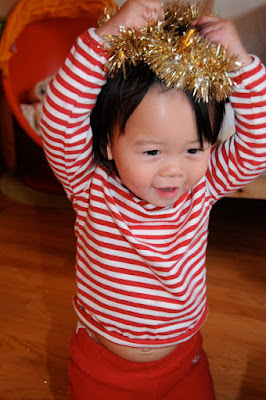Tree triming party
On Saint Nicolas' eve (Dec 5) we invited friends from Alice's kindergarten to trim our tree.
From Wikipedia:
Saint Nicholas Day
The tradition of Saint Nicholas Day, usually on 6 December, is a festival for children in many countries in Europe related to surviving legends of the saint, and particularly his reputation as a bringer of gifts. The American Santa Claus, as well as the Anglo-Canadian and British Father Christmas, derive from these legends. "Santa Claus" is itself derived from the Dutch Sinterklaas.
The Netherlands, Belgium, and Lower Rhineland (Germany)
Main article: Sinterklaas
In the Netherlands, Saint Nicholas' Eve (5 December) is the primary occasion for gift-giving, when his reputed birthday is celebrated.
In the days leading up to 5 December (starting when Saint Nicholas has arrived in the Netherlands by steamboat in late November), young children put their shoes in front of the chimneys and sing Sinterklaas songs. Often they put a carrot or some hay in the shoes, as a gift to St. Nicholas' horse. (In recent years the horse has been named Amerigo in The Netherlands and Slechtweervandaag in Flanders.) The next morning they will find a small present in their shoes, ranging from sweets to marbles or some other small toy. On the evening of 5 December, Sinterklaas brings presents to every child who has behaved him- or herself in the past year (in practice, just like with Santa Claus, all children receive gifts without distinction). This is often done by placing a bag filled with presents outside the house or living room, after which a neighbour or parent bangs the door or window, pretending to be Sinterklaas' assistant. Another option is to hire or ask someone to dress up as Sinterklaas and deliver the presents personally. Sinterklaas wears a bishop's robes including a red cape and mitre and is assisted by many mischievous helpers with black faces and colourful Moorish dress, dating back two centuries. These helpers are called 'Zwarte Pieten' ("Black Petes") or "Père Fouettard" in the French-speaking part of Belgium.
The myth is, if a child had been naughty, the Zwarte Pieten put all the naughty children in sacks, and Sinterklaas took them to Spain (it is believed that Sinterklaas comes from Spain, where he returns after 5 December). Therefore, many Sinterklaas songs still allude to a watching Zwarte Piet and a judging Sinterklaas.
In the past number of years, there has been a recurrent discussion about the politically incorrect nature of the Moorish helper. In particular Dutch citizens with backgrounds from Suriname and the Netherlands Antilles might feel offended by the Dutch slavery history connected to this emblem and regard the Zwarte Pieten to be racist. Others state that the black skin color of Zwarte Piet originates in his profession as a chimneysweep, hence the delivery of packages though the chimney. [16]
In recent years, Christmas (along with Santa Claus) has been pushed by shopkeepers as another gift-giving festival, with some success; although, especially for young children, Saint Nicholas' Eve is still much more important than Christmas. The rise of Father Christmas (known in Dutch as de Kerstman) is often cited as an example of globalisation and Americanisation.[17]
On the Frisian islands (Waddeneilanden), the Sinterklaas feast has developed independently into traditions very different from the one on the mainland.[18]













No comments:
Post a Comment